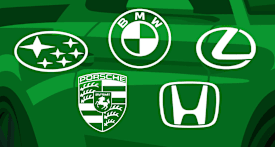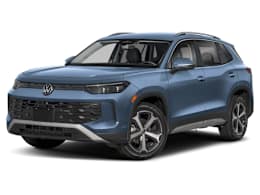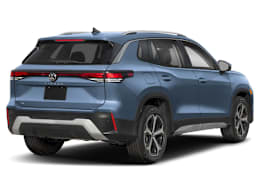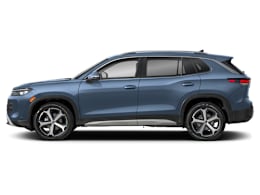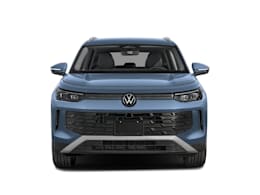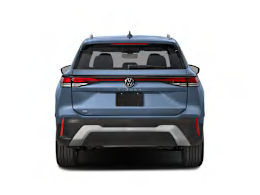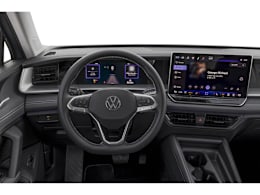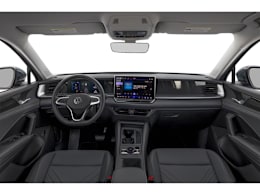The compact SUV class is chock full of worthy competitors, and judging them is similar to an Olympic event: Every entrant is at the top of their game, even if they don’t get a medal. In recent years, the Volkswagen Tiguan has wallowed far off the podium due to sluggish acceleration, iffy reliability, and below-average owner satisfaction from CR’s members.
But for 2025, the redesigned Tiguan, now in its third generation, has returned to the arena after some intense training. Its engine is more powerful, its sheet metal is more streamlined, and it shed its third-row seat option and got new touchscreen-based controls.While the redesign brought with it some improvements, such as quicker acceleration, it also sees some downgrades, in the form of worse low-speed drivability, a slight decrease in fuel efficiency, and much more frustrating controls.
In fact, its road-test score actually dropped a few points compared to the previous generation. VW’s recent history of below par reliability further tempers the Tiguan’s appeal.
That’s a shame because the Tiguan—Volkswagen’s bestselling model—has some notable advantages over much of its competition, including engaging handling, comfortable front seats, a super-roomy rear seat, and a nicely furnished cabin.
“Nothing really blew me away about this car,” said one of our testers. “The powertrain, and in particular the unrefined nature of the transmission at times, was the biggest letdown for me. It handles quite well, maybe just a bit below something like a Mazda CX-50. But with the Tiguan’s past reliability record, I fail to see a compelling reason to choose it over any of its competitors.”
“To me, it comes across as a slightly larger, noticeably quieter Taos, but with worse controls, worse handling, middle-of-the-road ride quality, and a just-okay powertrain,” said another tester. “I liked the driver's seat and how easy it is to get in and out of it, but nothing else really stood out to me.”
We bought a 2025 Volkswagen Tiguan SE 4Motion for $36,825—anonymously from an area dealer, as we do with every vehicle we test—for the purpose of this road test review. Our Tiguan was assembled in Puebla, Mexico.
Driving experience
When cruising leisurely around town, the Tiguan’s combination of a 201-hp, 2.0-liter turbocharged four-cylinder engine and an eight-speed automatic transmission works fairly well, with decent power and smooth shifts. But certain situations result in either a delay of power or an uneven delivery, or sometimes both. For example, when you try to re-accelerate after slowing down—like when the driver ahead of you turns off onto another road—the transmission hesitates before it shifts down to a lower gear. Then, by the time it makes up its mind, the power often gets delivered in an abruptly forceful fashion. Further, the first couple of upshifts are typically fairly pronounced at slightly harder throttle openings, and rolling stops come with noticeable power delays.
But the powertrain also has some strengths. Once underway, and in particular if you’re more gentle with the gas pedal, the transmission shifts quite smoothly. The engine also has strong mid-range torque, which makes for good passing power. The transmission also does a good job of downshifting when it senses that the engine is getting into an uncomfortable, low-rpm lugging situation when just cruising along at a steady-state throttle. By the numbers, acceleration is noticeably improved, with 0 to 60 mph arriving in 8.9 seconds, vs. the previous Tiguan’s rather pokey 10.3 seconds. While not class-leading, this at least makes the Tiguan competitive within the segment.
Fuel economy, unfortunately, took a 1-mpg dip compared to the previous generation, possibly due to the extra 17 hp that the new Tiguan is packing. It managed 24 mpg overall in our testing.
Handling is a Tiguan strong suit, and one of the standout reasons buyers might want to consider it over the multitude of other compact SUVs. It feels more nimble and tied-down through corners than most rivals, aided by responsive steering and a taut suspension that keeps body roll nicely at bay. Ride comfort takes a back seat to handling, with a very firm quality about it. It’s not to the point of being harsh, and it doesn’t get unruly or unrefined, but larger bumps tend to come through with a pretty pronounced impact.
Braking performance was just so-so. Stopping distances were competitive on our dry surface, but a bit on the long side vs. many competitors on wet pavement. Brake-pedal feel isn’t the best, either. Several testers were disappointed by an initial “dead spot” when you first press down on the pedal, where it does very little to slow the car.
Volkswagen did a good job subduing most wind, road, and tire noise. The four-cylinder engine can sound a bit strained when passing or accelerating hard. Some testers enjoyed hearing the “whoosh” of air surging through the turbocharger, but its underlying wheezing sounds were less pleasant.
Cabin comfort
The Tiguan’s quality interior is another big selling point. It has a clean and minimalist European look that isn’t fancy, yet delivers a solid feel. Switches and buttons move with a damped fluidity, and although most of the materials are plastic, the soft suede accents and leather-wrapped steering wheel add some warmth.
The driver benefits from plenty of headroom, a well-placed left footrest, and a nicely padded door armrest. The plastic center console can hem in the driver’s right knee, though, and several testers noted that when they had the steering wheel in a lower, more comfortable position that the rim blocks the turn signal and headlight icons from view.
The front seats were almost unanimously liked. They stand out as some of the best in the class, due to their combination of comfortable padding and lateral support. Plus, the driver’s seat in our tested second-tier SE trim has four-way lumbar adjustment—a pleasant surprise in a sub-$40,000 SUV.
The rear seat gets points for space and comfort, especially for the compact SUV class. It has decent headroom, ample knee room, and lots of foot space underneath the front seats. The bottom cushion provides decent underleg support.
We were able to fit four large suitcases behind the rear seat, which is competitively spacious among compact SUVs. Maximum cargo volume, measured with the rear seats folded down, lags a few cubic feet behind some competitors, though.
Controls and usability
The previous Tiguan had some of the easiest-to-use buttons and knobs in the business. The new model’s controls certainly aren’t as easy to use as the old ones, but they aren’t quite as difficult as those in the ID. Buzz and ID.4 electric models. The infotainment touchscreen responds quickly and is easy to see, and it’s simple to switch back and forth between the built-in infotainment system and Android Auto and Apple CarPlay.
Unfortunately, all of the climate functions have been moved into the infotainment screen and a capacitive-touch slider bar just below it, and they simply aren’t as straightforward to use as the previous physical knobs and buttons. On the other hand, we appreciate that the Tiguan has conventional steering-wheel buttons, as opposed to the annoying touch sliders and flush panels found in the ID. Buzz and ID.4. But we don’t like that VW crammed the wiper controls onto the turn signal stalk.
Active safety and driver assistance
The Tiguan comes standard with a host of active safety and driver assistance features, including automatic emergency braking with pedestrian and cyclist detection, automatic emergency braking that operates at highway speeds, blind spot warning, rear cross traffic warning, reverse automatic emergency braking, lane centering assistance, lane departure warning, lane keeping assistance, adaptive cruise control, and automatic high beams.
Volkswagen’s “Travel Assist” active driving assistance system comes standard. It pairs lane centering assistance with adaptive cruise control, and is designed to help steer the car and control acceleration and braking during highway driving. The Tiguan’s lane-centering performance is comparable to what we’ve seen in recent VWs—it keeps the vehicle centered within the lane by delivering smooth steering inputs, but there is some minor wavering back and forth within the lane.
We’re happy to see that both a rear occupant alert system and a belt minder come standard. The former is designed to remind the driver—based on rear-door logic—to check the rear seat when they turn the Tiguan off to help prevent children and pets from suffering heatstroke or hypothermia if unintentionally left behind in the vehicle. The rear belt minder alerts the driver if a rear passenger unbuckles their seat belt during the trip.

